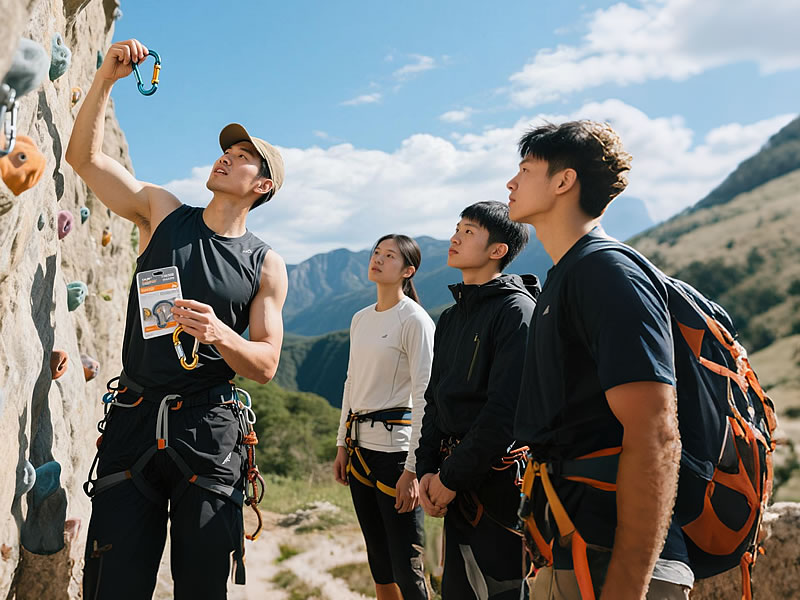Common mistakes when using carabiner clips (and how to avoid them).
Carabiner clips are deceptively simple tools, but even seasoned climbers and outdoor enthusiasts make critical errors that compromise safety. From improper loading to overlooked maintenance, here’s a breakdown of the most dangerous mistakes—and how to fix them before disaster strikes.

1. Cross-Loading: The Silent Strength Killer
Mistake: Loading a carabiner sideways (gate facing downward or sideways) reduces its strength by 50–70%. This often happens when attaching slings or anchors at odd angles.
Fix:
- Always align the carabiner’s spine (longest axis) with the load direction.
- Use oval-shaped carabiners for multi-directional loads.
- Avoid "American Death Triangles" in anchor setups.
2. Incomplete Locking: A Deadly Oversight
Mistake: Failing to fully close screwgate sleeves or assuming auto-locking carabiners are secure without a visual check.
Fix:
- For screwgates: Twist until no threads are visible and tug-test the sleeve.
- For auto-locks: Listen for an audible click and verify the gate is flush with the body.
3. Mixing Locking and Non-Locking Carabiners
Mistake: Using non-locking carabiners (e.g., wire-gate) for critical points like belay devices or anchors.
Fix:
- Follow the “Two Locking Rule”: Use two locking carabiners for life-critical systems (e.g., belay anchors).
- Reserve non-locking carabiners for gear loops or water bottles.
4. Ignoring Wear and Corrosion
Mistake: Using carabiners with rust, gate wobble, or hairline cracks.
Fix:
- Monthly Inspection: Check for:Gate action: Smooth opening/closing.Cracks: Magnify if necessary.Corrosion: Especially near the hinge or spine.
- Retire any carabiner dropped from height or exposed to acid (e.g., battery leaks).
5. Overloading Beyond Ratings
Mistake: Assuming "bigger is stronger"—ignoring kN ratings for dynamic vs. static loads.
Fix:
- UIAA/EN-certified carabiners list strength on the spine (e.g., 24 kN).
- For climbing, ensure major axis strength exceeds 20 kN.
- Never use non-certified carabiners (e.g., decorative or DIY) for loads.
6. Using Carabiners as Permanent Anchors
Mistake: Leaving steel carabiners outdoors for months, leading to UV degradation or rust.
Fix:
- Use stainless steel quick links for permanent installations.
- Replace outdoor carabiners annually if exposed to weather.
7. Poor Rope Management
Mistake: Letting ropes or slings rub against sharp edges while clipped to a carabiner.
Fix:
- Use rope protectors or nylon sleeves in abrasive environments.
- Opt for keylock carabiners (e.g., Black Diamond HotForge) to prevent snagging.
Pro Tips for Safer Use
- Color Code: Assign colors to roles (e.g., red for anchors, blue for personal gear).
- Double-Check Partners: Verify each other’s carabiners during pre-climb checks.
- Educate Newbies: Most mistakes happen due to inexperience—share this guide!
Top Carabiners for Error-Proofing
- Petzl Attache (Screwgate, 33 kN): Reliable for belaying.
- DMM Shadow (Auto-Lock, 24 kN): Lightweight and snag-free.
- CAMP Orbit Wire (Keylock, 22 kN): Budget-friendly for beginners.
Final Takeaway
Carabiner mistakes aren’t just user error—they’re often design or context failures. By understanding load physics, prioritizing certified gear, and adopting strict inspection habits, you’ll turn this humble tool into a trusted lifeline. When in doubt, ask: “Would I bet my life on this clip right now?” If the answer isn’t “absolutely,” rethink your setup.






